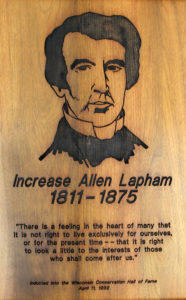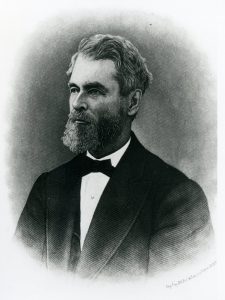“There is a feeling in the heart of many that it is not right to live exclusively for ourselves or for the present time – that it is right to look a little to the interests of those who shall come after us. ” – Increase A. Lapham
Increase A. Lapham came to Wisconsin at a time of resource abundance. His gift was the foresight to record the state’s natural history and to encourage its preservation. Born in New York, Lapham was a young surveyor and civil engineer who worked on the Erie Canal. He arrived in Milwaukee in 1836, three days before Wisconsin became a U.S. Territory.
A naturalist at heart, Lapham had an insatiable curiosity for the world around him. He was a prolific note-taker, recording every bird, flower and odd-looking stone he saw. He searched under logs and rocks for shells and recorded water levels and weather conditions.
He had a sincere desire to preserve a record of presettlement species in Wisconsin before they disappeared. He published information on trees, plants, shells and rocks. Without his efforts, much of the state’s pristine environment and original biotic diversity would be left to conjecture.
 He collected more than 1,500 species of plants, which he donated to the University of Wisconsin-Madison as an herbarium in 1949 – even before it had a botany department. Lapham made the earliest significant contributions to understanding the state’s geology, mineralogy, archeology and meteorology. He took great interest in the thousands of effigy mounds found near Wisconsin’s rivers and lakes. He precisely drew and described animal and geometric-shaped emblems that were created from soil by Native Americans during the Woodland Period. His acclaimed book of effigy mounds, Antiquities of Wisconsin, was published in 1855 under the auspices of the Smithsonian Institution.
He collected more than 1,500 species of plants, which he donated to the University of Wisconsin-Madison as an herbarium in 1949 – even before it had a botany department. Lapham made the earliest significant contributions to understanding the state’s geology, mineralogy, archeology and meteorology. He took great interest in the thousands of effigy mounds found near Wisconsin’s rivers and lakes. He precisely drew and described animal and geometric-shaped emblems that were created from soil by Native Americans during the Woodland Period. His acclaimed book of effigy mounds, Antiquities of Wisconsin, was published in 1855 under the auspices of the Smithsonian Institution.
In 1855, he urged state legislators to authorize a natural history survey “before any more of the native species become extinct.”
Lapham recognized the importance of forests to soils, watersheds and climate and warned of the devastation of state forests 50 years before it became a public issue. He advocated for preserving and replanting forests, calling it a duty of landowner~. Legislation creating a tax exemption for farmers who planted tree shelterbelts was passed in 1868, a year after he co-authored a paper on the effects of forest destruction.
When he became the Wisconsin state chief geologist in 1873, he conducted a two-year survey of the geology of the state. Many of his maps, statistics and other works are in the State Historical Library and Milwaukee Public Library.
Lapham developed the first storm warning system for the Great Lakes and is credited with fathering the National Weather Service. With modest persistence, Lapham was a bellwether of ecological concerns unknown in his day. He truly was the founder of the conservation movement in Wisconsin.
Resources
Increase Lapham Legislative Citation
Quotes from Increase Lapham, excerpts from AFIELD: Portraits of Wisconsin Naturalists, Empowering Leopold’s Legacy, by Sumner Matteson
Studying Wisconsin: The Life of Increase Lapham, by Martha Bergland and Paul G. Hayes, book review by Robert H. Dott, Jr.
Increase Allen Lapham, First Scholar of Wisconsin, by Milo M. Quaife from Wisconsin Magazine of History 1917
Increase Lapham, Wisconsin’s First Scientist by Erika Janik for Wisconsin Life, 2016
Increase Lapham – Wisconsin’s First Scientist from the Wisconsin Historical Society
Increase Lapham and the Founding of the United States Weather Bureau by Cole Roecker for Wisconsin 101 Our History in Objects, 2020
Increase Lapham, 1811-1875, tribute by A. W. Schorger (WCHF Inductee) for Wiscosin Conservation Bulletin
Photos
These images may be used under the Creative Commons Attribution-NonCommercial-NoDerivatives 4.0 International License.





